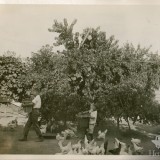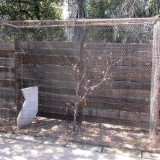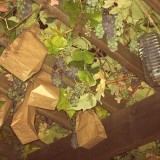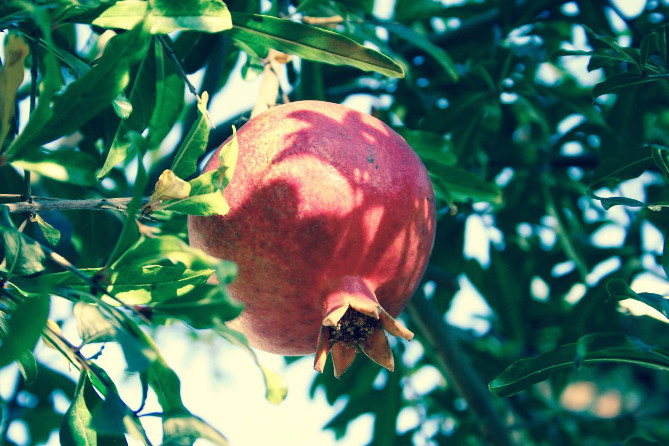 We’ve been guilty in the past of claiming that growing fruit is labor-free. That’s a lazy blogger’s lie. The truth is that you have to stay on top of pruning, irrigation, fruit thinning, fertilizing and pest prevention if you want to harvest any fruit. After not getting a single peach off our small tree last year due to squirrels, I vowed to do things differently this year.
We’ve been guilty in the past of claiming that growing fruit is labor-free. That’s a lazy blogger’s lie. The truth is that you have to stay on top of pruning, irrigation, fruit thinning, fertilizing and pest prevention if you want to harvest any fruit. After not getting a single peach off our small tree last year due to squirrels, I vowed to do things differently this year.
I considered a number of squirrel prevention techniques:
- Metal collars on trunks. This doesn’t work, especially in urban areas. Squirrels are superb acrobats and can simply jump from a roof, fence or adjacent tree on to your fruit tree.
- Trapping, killing, hunting. I don’t have the heart to do this and it’s illegal in urban areas but it is what professional orchardists do.
- Electronic or visual frightening devices. According to UC Davis, these don’t work. Squirrels aren’t dumb.
- Dogs. Maybe, but it depends on the dog. Our late doberman was more interested in alerting us to the mail carrier’s rounds. He was more interested but, ultimately, unsuccessful in his 13 year battle against skunks.
Exclusion with plastic bird netting is the most promising technique for urban areas. In order to do this you need to keep the tree pruned to a manageable size. I purchased a 14-foot by 14-foot piece of bird netting and Kelly and I put it on the tree (it’s a two-person job as bird netting is a pain to work with). We secured it with clothes pins. You must be absolutely certain to leave no gaps in the net. If you leave a gap you could trap birds and the squirrels will also work their way in. The next step is to keep a close eye on the fruit and harvest it as soon as you can, perhaps a little sooner than is ideal.
Unfortunately, squirrels can easily chew through bird netting so this method is far from foolproof. According to UC Davis, exclusionary methods will only work if the squirrels have other things to eat. Another argument for biodiversity in our landscapes, I suppose.
If you know of any foolproof squirrel prevention techniques please leave a comment!
Support Root Simple
KoMo Fidibus 21 Grind your own flour!






Where did you purchase your bird netting? I’m currently losing strawberries and cherry tomatoes to mockingbirds!
Home Depot. Nurseries also have it.
As for strawberries and (maybe) cherry tomatoes, I’ve seen where people painted rocks to look like the fruit and put them in the area before the fruit ripened. The idea is that the birds get tricked into pecking at the rocks and won’t bother the real stuff later on. I haven’t yet tried it, but it might work.
Linda, the painted rocks can work to discourage birds, but they don’t work if you have squirrels that steal berries. And tacking bird netting over my strawberry patch didn’t work last year either, since the squirrels just reach through it. This year I’m going to build a PVC cage to go over the strawberry patch — hopefully that works!
Coating the whole tree with castile soap and garlic/chili oil?
Biodynamic squirrel preparation?
Did your peach tree spring back to life this year or is this from years past?
No, it’s the same tree we’ve had for a few years now. And the photo was taken yesterday. Today I’m going to remove all the fruit.
You state that trapping is illegal in urban areas – I don’t think this is exactly correct. Hunting is illegal.
Trapping needs to follow certain guidelines. Here is LA County policy on trapping, via their website http://file.lacounty.gov/acwm/cms1_215273.pdf
We like The Tube with peanut butter bait. It looks like this http://www.forestry-suppliers.com/product_pages/Products.asp?mi=44491&itemnum=35803&redir=Y
Thanks Joanne!
White floating row covers! I use it to protect everything! Much easier to work with than bird netting. I use rocks to hold it down over strawberry beds (and the like) and use clothes pins to secure it around upright fruit bushes. It also keeps cats out of my raised beds (giant litter boxes to them!). I’ve also had great luck protecting my rows of raspberries from robins and cedar waxwings with old curtain sheers I bought at Goodwill. They don’t get caught up in the prickles like the floating row covers would.
Trap ‘n release. Here’s what I use. 8 squirrels in the first 2 weeks.
http://squirrelinator.com/
The problem with bird netting is the birds, bats and other critters can get caught in it. I instead use Tanglefoot, I tie a piece of cloth or heavy paper around part of the trunk of the tree and spread the Tanglefoot on the paper. It keeps the squirrels and raccoons from climbing up the tree as they don’t like the sticky stuff on their paws. To keep the ‘fence jumping critters’ off I use a light floating row cover after the fruit forms and before it ripens. Keeps everybody happy. 🙂
We don’t have fruit for them to steal yet,but my husband uses an airsoft gun to keep them off the feeders in the fall. Then w have a big squirrel barbeque or stew… the biggest pest I have in my strawberries is actually ants.
My 70 year old aunt from Taiwan re-purposed our leftover mesh bags from bridesmaid favors – the fine mesh kind with the very tight drawstring. She uses them on her peach, plum, apples and persimmons and it seems to work pretty well. Maybe it’s silly, but it works for her!
Your “Foolproof” link (last one in your article) Rickrolls! I hadn’t seen that video in 25 years – what a riot :-). meb
We use the clear plastic containers that cherry tomatoes come in – they allow in light and air, but seem to foil the squirrels. Downside, it’s the tree equivalent of the plastic cones that dogs get at the vet – they’re ugly, and they weigh the branches down a bit. Also experimenting this year with the net bags from onions.
Fruit trees tend to take a lot of care to keep them in good shape if you want them to keep producing fruits, and often you’ll need to buy at least 2 so that they’ll pollinate each other (some trees won’t bear fruit at all without that).
Trap and move, consistently.
Build a frame/cage (up to 10′) out of PVC pipe or elec. conduit pipe and attach aviary wire on all sides and the top. Leave part of one side so that you can open to prune and to harvest your fruit. It’s a bit of work, but if you have a good, productive tree, you’ll be able to enjoy the fruit for a number of years. “It’s worth it!”, I say. We have three such cages at our home at Lake Isabella, Calif.
I’ve seen cages like this and it’s probably the best long-term solution. Planning for such a cage is something I wish I would have thought about before planting the trees.
Get yourself a big cat and watch your rodent problems disappear.
Pingback: Science, Blogging and Peaches | Root Simple